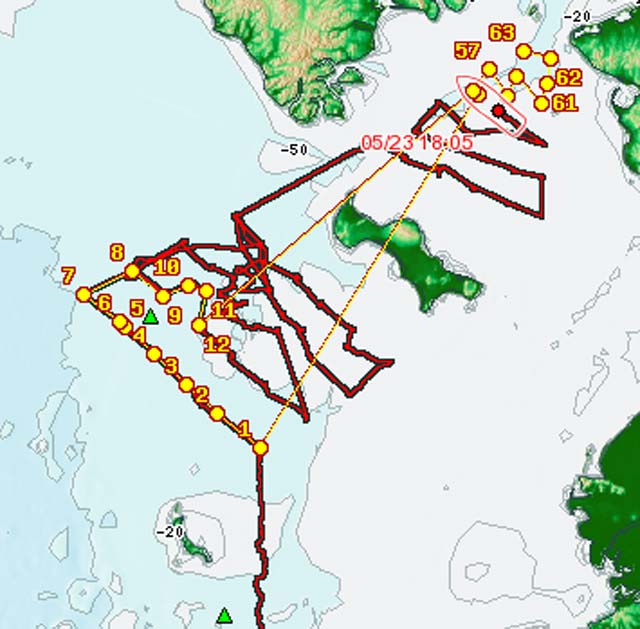( Log In ) Log In is for TREC Teachers & Researchers only
| Samantha_Dassler_Barlow |
 May 30 2006, 06:20 PM May 30 2006, 06:20 PM
Post
#1
|
 Advanced Member    Group: TREC Team Posts: 99 Joined: 12-April 06 Member No.: 23 |
Date: Tuesday, May 23, 2006
GPS Coordinates Latitude: 64° 51.1’ N Longitude: 169° 18.8’ W  Map Caption: We are quickly zipping through the stations that are north of St. Lawrence Island. We are headed towards Little Diomede Island in the Bering Strait. Today was another beautiful day. I think we are very lucky to have such beautiful weather these past couple of days. The trawls and the vanVeen grabs have been bringing up pieces of rocky bottom with barnacles and different types of critters than we saw south of St. Lawrence Island. Before, it was very muddy with thousands of brittle stars. Now, there are a lot less brittle stars. There is an animal that I have wanted to see since before I started this journey. I have always wanted to sight a whale in the wild. I’ve seen them at Sea World before, but that just isn’t the same. I have spent a lot of time on the bridge behind a pair of binoculars and it seems like a whale always shows up 5 minutes after I leave and by the time I get back outside, it is gone. I think everyone has seen a whale but me up to this point. Today was different. I finally saw a whale! In fact, I saw a bunch of them. We must have come upon a whole herd of gray whales passing through the Bering Strait. They were always a little too far and too fast for me to get any pictures, so I gave up on the camera and stood for hours staring at the water through a pair of binoculars. Gray whales rarely breach, or jump out of the water like other whales. These whales skim near the surface so that we mostly saw their blows, heads, and backs. Their heads and backs are very bumpy. Occasionally, as the whales got ready to dive a little deeper, we saw the fluke (the lobes of the tail) for just a second before it disappeared underwater. Gray whales (Eschrichtius robustus) are classified as baleen whales. Baleen is the bristle-like hairs that this type of whale uses to filter feed. Gray whales are unique to filter feeding, baleen whales in that they are they only species to muck around at the bottom of the sea in the mud to gulp up amphipods, the main part of their diet. They use their baleen to strain out the amphipods from a mouthful of muddy seawater. I was able to purchase a piece of carved bowhead whale baleen (Balaena mysticetus) from a St. Lawrence Island Yupik hunter that visited our ship. The baleen of this whale is very long and fine. It feels like hair from a horse’s tail. Bowhead whales skim zooplankton (copepods, euphausids, and amphipods) found near the surface of the water. I can’t wait to show everyone back home what my piece of baleen looks like.  I was able to purchase this piece of carved bowhead whale baleen from a St. Lawrence Island Yupik hunter that visited the Healy. The hairs of this type of baleen feel similar to the hairs of a horse’s tail. A bowhead whale uses its baleen to filter feed by straining out zooplankton (copepods, euphausids, and amphipods) from near the surface of the water. Special thanks to the scientists for helping identify the whales and told me all about them when we first spotted them. Also, thanks to my Audubon Society Field Guide to North American Fishes, Whales, & Dolphins and to my friend Liz who let me borrow her book, Guide to Marine mammals of Alaska by Kate Wynn of the Alaska Sea Grant College Program at UAF. |
Posts in this topic
  |
1 User(s) are reading this topic (1 Guests and 0 Anonymous Users)
0 Members:

|
NSF Acknowledgment & Disclaimer | Time is now: 1st November 2024 - 12:59 AM |
Invision Power Board
v2.1.7 © 2024 IPS, Inc.









